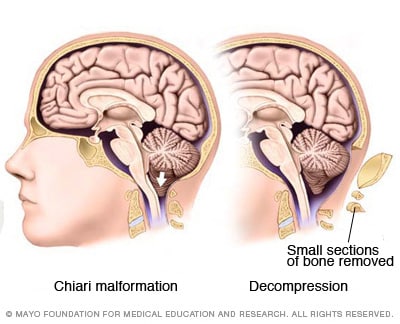Overview
Chiari malformation

Chiari malformation
In Chiari malformation surgery, doctors remove a small section of bone at the back of your skull to make room for part of your brain (cerebellum) and relieve pressure on your brainstem, cerebellum and spinal cord.
Chiari malformation (kee-AH-ree mal-for-MAY-shun) is a condition in which brain tissue extends into the spinal canal. It occurs when part of the skull is misshapen or smaller than is typical, pressing on the brain and forcing it downward.
Chiari malformation is uncommon, but increased use of imaging tests has led to more-frequent diagnoses.
Doctors categorize Chiari malformation into three types, depending on the anatomy of the brain tissue that is displaced into the spinal canal and whether developmental problems of the brain or spine are present.
Chiari malformation type 1 develops as the skull and brain are growing. As a result, signs and symptoms may not occur until late childhood or adulthood. The pediatric forms, Chiari malformation type 2 and type 3, are present at birth (congenital).
Treatment of Chiari malformation depends on the form, severity and associated symptoms. Regular monitoring, medications and surgery are treatment options. In some cases, no treatment is needed.
Products & Services
Symptoms
Many people with Chiari malformation have no signs or symptoms and don't need treatment. Their condition is detected only when tests are performed for unrelated disorders. However, depending on the type and severity, Chiari malformation can cause a number of problems.
The more common types of Chiari malformation are:
Although these types are less serious than the rarer pediatric form, type 3, signs and symptoms still can be life disrupting.
Chiari malformation type 1
In Chiari malformation type 1, signs and symptoms usually appear during late childhood or adulthood.
Headaches, often severe, are the classic symptom of Chiari malformation. They generally occur after sudden coughing, sneezing or straining. People with Chiari malformation type 1 can also experience:
- Neck pain
- Unsteady gait (problems with balance)
- Poor hand coordination (fine motor skills)
- Numbness and tingling of the hands and feet
- Dizziness
- Difficulty swallowing, sometimes accompanied by gagging, choking and vomiting
- Speech problems, such as hoarseness
Less often, people with Chiari malformation may experience:
- Ringing or buzzing in the ears (tinnitus)
- Weakness
- Slow heart rhythm
- Curvature of the spine (scoliosis) related to spinal cord impairment
- Breathing problems, such as central sleep apnea, which is when a person stops breathing during sleep
Chiari malformation type 2
In Chiari malformation type 2, a greater amount of tissue extends into the spinal canal compared with that in Chiari malformation type 1.
The signs and symptoms can include those related to a form of spina bifida called myelomeningocele that nearly always accompanies Chiari malformation type 2. In myelomeningocele, the backbone and the spinal canal don't close properly before birth.
Signs and symptoms may include:
- Changes in breathing pattern
- Swallowing problems, such as gagging
- Quick downward eye movements
- Weakness in the arms
Chiari malformation type 2 is usually noted with ultrasound during pregnancy. It may also be diagnosed after birth or in early infancy.
Chiari malformation type 3
In the most severe type of the condition, Chiari malformation type 3, a portion of the lower back part of the brain (cerebellum) or the brainstem extends through an opening in the back of the skull. This form of Chiari malformation is diagnosed at birth or with an ultrasound during pregnancy.
This type of Chiari malformation has a higher mortality rate and may also cause neurological problems.
When to see a doctor
If you or your child has any of the signs and symptoms that may be associated with Chiari malformation, see your doctor for an evaluation.
Because many symptoms of Chiari malformation can also be associated with other disorders, a thorough medical evaluation is important.
Causes
Chiari malformation type 1 occurs when the section of the skull containing a part of the brain (cerebellum) is too small or is deformed, thus putting pressure on and crowding the brain. The lower part of the cerebellum (tonsils) is displaced into the upper spinal canal.
Chiari malformation type 2 is nearly always associated with a form of spina bifida called myelomeningocele.
When the cerebellum is pushed into the upper spinal canal, it can interfere with the normal flow of cerebrospinal fluid that protects the brain and spinal cord.
This impaired circulation of cerebrospinal fluid can lead to the blockage of signals transmitted from the brain to the body, or to a buildup of spinal fluid in the brain or spinal cord.
Alternatively, the pressure from the cerebellum on the spinal cord or lower brainstem can cause neurological signs or symptoms.
Risk factors
There's evidence that Chiari malformation runs in some families. However, research into a possible hereditary component is still in its early phase.
Complications
In some people, Chiari malformation can become a progressive disorder and lead to serious complications. In others, there may be no associated symptoms, and no intervention is necessary. The complications associated with this condition include:
- Hydrocephalus. An accumulation of excess fluid within the brain (hydrocephalus) may require placement of a flexible tube (shunt) to divert and drain the cerebrospinal fluid to another area of the body.
- Spina bifida. Spina bifida, a condition in which the spinal cord or its covering isn't fully developed, may occur in Chiari malformation. Part of the spinal cord is exposed, which can cause serious conditions such as paralysis. People with Chiari malformation type 2 usually have a form of spina bifida called myelomeningocele.
- Syringomyelia. Some people with Chiari malformation also develop a condition called syringomyelia, in which a cavity or cyst (syrinx) forms within the spinal column.
- Tethered cord syndrome. In this condition, the spinal cord attaches to the spine and causes the spinal cord to stretch. This can cause serious nerve and muscle damage in the lower body.
Sept. 24, 2021